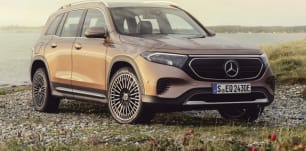This should be the GLB’s calling card. It’s a car with an ideal footprint, not as wide or as long as most mid-size SUVs, whilst also offering a larger cabin and boot.
The big drawback for this variant in particular is the lack of a seven-seat option, as the all-wheel drive requires the under-floor space which is required to give rear occupants legroom.
It’s a shame, too, because I found the two rear seats in this car’s GLB combustion equivalent to be surprisingly accommodating for even adults.
As a result of these missing seats, though, the full volume can be exploited in the boot, which comes in at a whopping 495 litres.
It’s rivalled by the Model Y, which also has a cavernous boot, although it has a much larger storage area than the Volvo XC40.
As an added bonus, there is a decent under-floor storage area which has enough space for all your charging cables, although there is no so-called ‘frunk’ with what is normally the engine bay taken up by cooling and auxiliary hardware.
At first glance there’s so much going on under there, you’d be forgiven for thinking the EQB has an actual engine!
The cabin is also enormous as well as configurable. The EQB has massive rear doors (as it’s designed to be a seven-seater) to make it easy to get in and out of, and once you’re settled in, the amount of space for me (at 182cm) behind my own driving position is very impressive, with ample leg, arm, and headroom.
Rear passengers score the same nice synthetic leather seat and door trim as the front passengers, a bottle holder in each door, as well as two in a flip-out caddy on the drop-down armrest, two nets on the backs of the front seats, dual adjustable air vents, and power outlets on the back of the console. There is also a separate section of the split sunroof to benefit those in the back seat.
Up front the cabin is equally flexible, although it immediately seems odd that the front seats are manually adjustable. Almost unforgivable in a $100,000 car.
At least the trim is comfortable, and again, the space is configurable for people of all shapes and sizes.
Storage options include large bins in each door, a split-opening armrest console with USB-C outlets inside, a slide-open area underneath the climate unit, which houses a wireless phone charger and additional power outlets, as well as the usual glove box arrangement.
Soft trims continue into the doors, although one small annoyance is the excess of chrome trim which has the unfortunate habit of reflecting harsh Australian sun into your eyes if it hits at the wrong angle.
The software is nice and quick, but can be cumbersome and over-complicated to operate at times, particularly when using the centre touchpad, or adjusting the dash with the small touch elements on the wheel.
It is also notable the Apple CarPlay as-tested only took up a centre portion of the screen, and is not set-up for widescreen mode to take full advantage of the hardware.
Minor complaints aside, though, the EQB follows its combustion GLB twin in having by far one of the most flexible and configurable cabins in its class.

